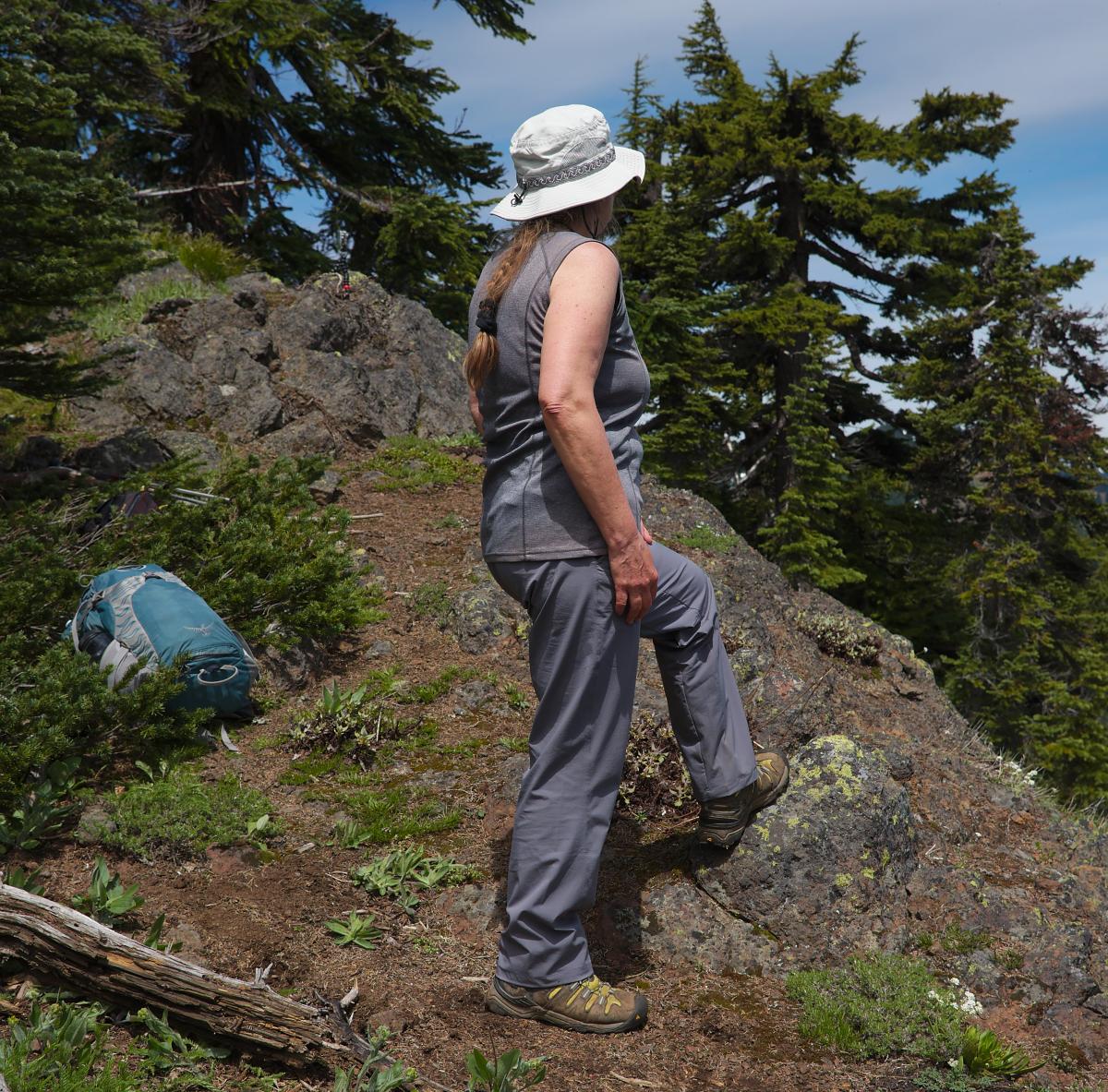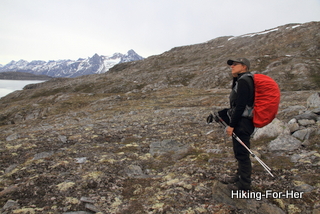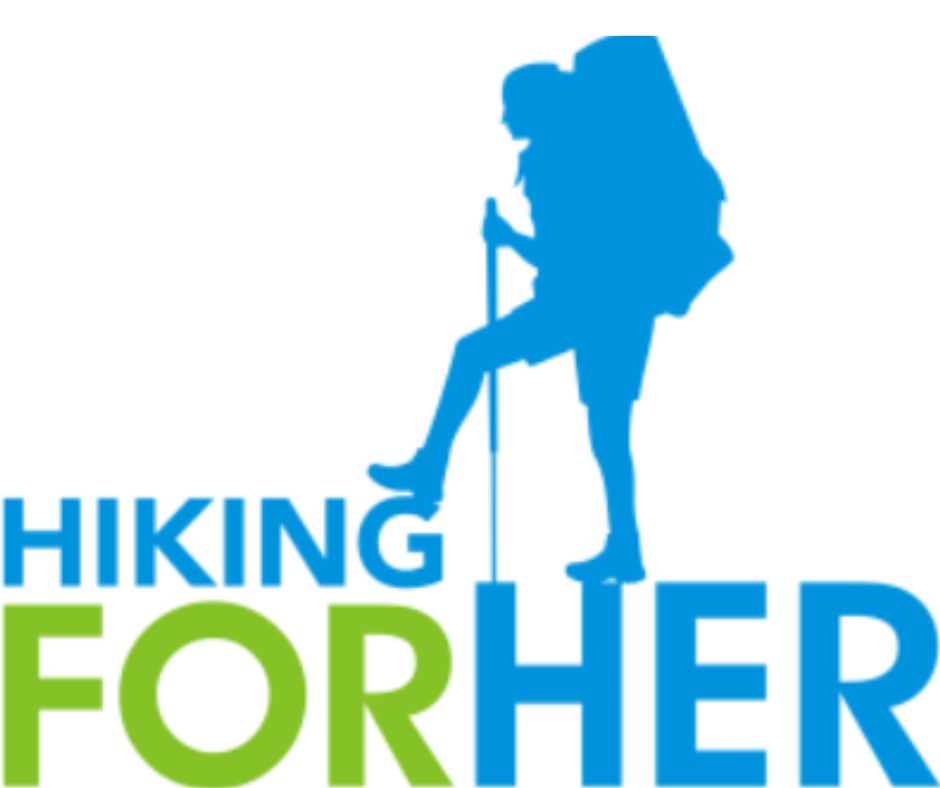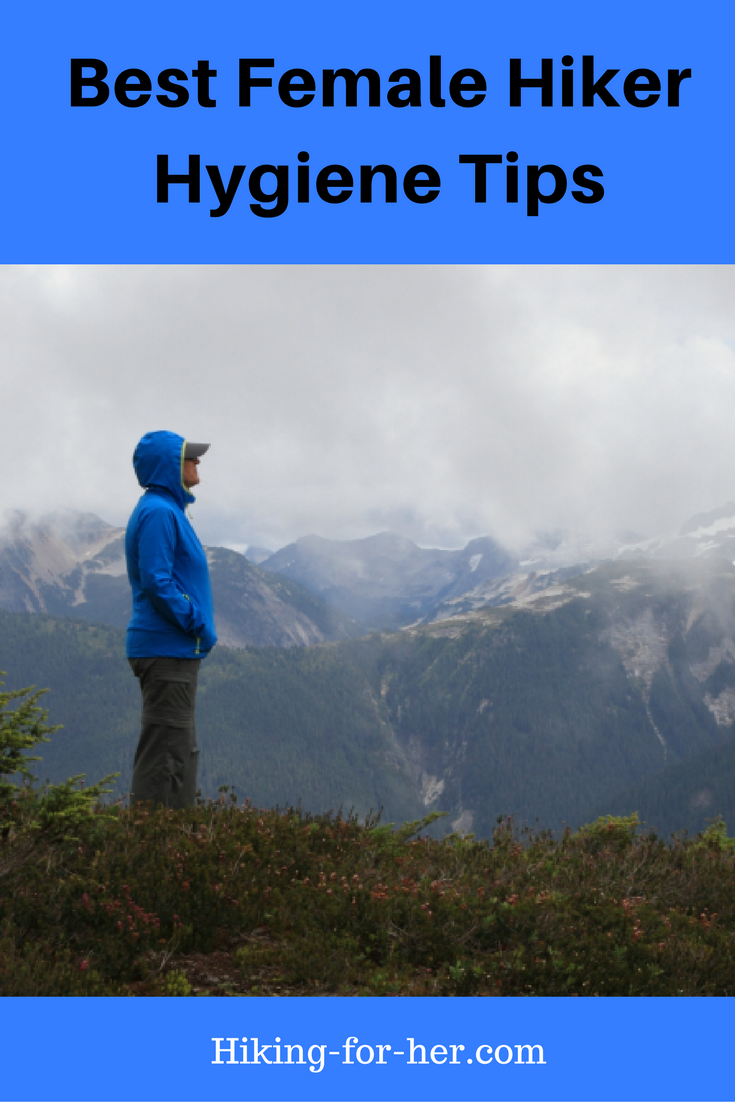Best Female Hiker Hygiene Tips
For Dayhiking And Backpacking
By Diane Spicer
Female hiker hygiene is a big topic of discussion for women hikers. I get a lot of questions about how to stay clean and look presentable on a hiking trail, with good reason.
- Cut to the chase here
Working up a sweat as a female is a two sided coin, because you fall into two mutually exclusive categories:
- praised (working up a sweat is working out, go girl!) -and-
- vilified (stinky, smelly, unattractive, unfeminine you)
What's a female hiker gonna do about personal hygiene?
Be proactive by using the plethora of best female hiker hygiene tips on this page.
- Hiking For Her is an authority on female hiker hygiene simply because she's hiked for the last 5 decades as a woman!
Body fluids are great!
Wait, what?
Yes, let's start with a shout out to your body fluids.
Your body produces an amazing amount of waste products. And that's a good thing!
- Here are some general tips on body fluids and their impact on female hiker hygiene.
Need some ideas on putting together a customized backpacking hygiene kit to deal with your fluids (and solids)?
And there's an upside to your sweat: it may be attractive to your male hiking partner!
Leave no trace ... of wastes
Because you're a biological being, moment by moment you produce waste products which can impact the natural environment as well as other hikers.
It's important to plan your hiking around Leave No Trace Hiking principles.
- 'Cuz brown toilet paper and used tampons are no fun to find on the trail.
Best personal hygiene
tips
for women hikers
Now let's cover a few specific tried and true personal hygiene tips for women hikers, so you can hit the trail but stay clean and comfortable regardless of what day of the month it is, or how hard you sweat.
Remember Priority One in Female Hiker Hygiene:
Feeling great!
That time of the month
feminine hygiene products
"It's that time of the month during a multi day hiking trip. Help!"
You have several ways to tackle this female hiker hygiene personal protection issue while backpacking.
But failing to plan ahead is not among them, unless you like scrambling around with safety pins, bandannas, and any available moss or lichens.
Option 1:
Skip your period on purpose
Talk with your health care provider about a "birth control" prescription which will allow you to control exactly when you bleed.
This short term solution has associated risks, so be sure you have a complete discussion on the pros and cons before taking this step.
Option 2:
Forethought & planning
Keep a supply log of all of the feminine hygiene products you use during your next period.
Also record your comfort level on each day (cramping, amount of flow, odors) and which supplies you needed to remain comfortable.
- In fact, do this for several
months, to be sure you have minimum and maximum data.
Now you know exactly how much to pack!
- Throw in a few extras, as a precaution.
- You will need to carry a dedicated plastic bag for your waste products, and dispose of this once you reach a garbage can.
Trail tip:
In your log, also record your food cravings.
Plan to have them in your backpack as a little reward for yourself.
- Keeping your morale high even when you're cramping and bleeding is priceless!
Option 3:
Internal collection cup for flow
This approach to feminine hygiene is not for everyone, but in case you're willing to consider this idea, here's a way to avoid paper products (tampons or sanitary pads):
a menstrual cup.
Yes, it's just what it sounds like - an internal cup to collect your flow.
You decide when it's convenient to empty the cup (it can be left in place overnight), and you also need to keep it clean.
Hand hygiene is essential, so also carry hand sanitizer (although good old soap and water is best long term as it's less drying to your skin).
Here's a popular brand of menstrual cup to consider: The Diva Cup.
Tip: Be sure to purchase the right size, because it needs to fit correctly to avoid leaks. You also want to choose a size according to how heavy your flow can be.
Hiking underwear dilemmas
& how to solve them
"I plan on working up a sweat, but I'm not sure which type of underwear will keep me as cool and clean as possible."
Let's start at the bottom and work our way up in our search for female hiker hygiene solutions to the hiking underwear dilemma.
Hiking For Her underwear recommendations (undergarments, underpants, panties, knickers, you know - the base layer for your bottom!) come in all sorts of fabrics.
That's
because the best women's underwear for hiking will change with the
season, as well as when you change your hiking pants or skirt style.
To find the best hiking underwear for your hiking style, consider the following questions and possible solutions.
Will this underwear cling and create chafing?
To solve this potential challenge to female hiker hygiene and comfort on a day hike, think nylon and nylon blends with a cotton panel in the crotch area.
Low cuts or thongs may be too skimpy to prevent chafing from your pants rubbing against your pack.
- Not to mention the "creep into the crack" issues.
But you might not want waist high underwear, either.
- Too binding around your waist, especially if you already have a camera bag strap and your backpack strap and your belt to consider.
So I recommend that you aim for a mid rise cut which covers you enough to prevent chafing, and is slippery enough to move with your layers during your hike.
Here are two of my current favorites:
and
Trail tip:
To deal with chafing issues anywhere on your body, try this "slippery on purpose" product for women hikers:
Will
this hiking underwear soak up sweat & stay wet
against my skin all day?
Pure cotton women's underwear is notorious for doing this!
If you're hiking on a hot sunny day, no worries.
But cotton is to be avoided at any other time - and not just for your base layer.
- This is a basic hiking mantra!
You might have to invest a bit of money into underwear which wicks moisture away from your body.
But moisture wicking women's underwear is worth it for multi day hiking trips because you'll be more comfortable regardless of temperature.
Antimicrobial fabrics are the way to go, if you want to avoid odors, too. That's a top priority in female hygiene while backpacking.
Again, ExOfficio wins. These are the best solution I've found for wicking, odor resistant hiking underwear.
Can I wash & dry this hiking underwear quickly?
Ah! Great female hiker hygiene question!
And yet another reason to avoid cotton: it dries slowly, or not at all in high humidity or cold conditions.
But if you have a nylon blend hiking panty, you can:
- swish it in soapy water,
- give it a quick rinse,
- squeeze the moisture out,
- hang
it to dry on the outside of your backpack the next day, and
- expect it to be ready to go the next morning (except in really cold or humid conditions).
You can alternate between 3 pairs of hiking panties (wear one, wash one, and a backup pair in your backpack).
More drying tips:
Use a sunny rock when available for drying purposes.
Or hang your freshly washed hiking underwear inside your tent overnight.
- Tip: Be sure the underwear is securely fastened above your head. I once woke up from a nightmare of wrestling an octopus to find myself with my hiking underwear on my head :(
Full cut nylon briefs like these will play well with your hiking pants, and dry fast.
Yes, they look like granny underwear, but we must do what we must do for good female hiker hygiene on the trail!
What about smelly unpleasant odors?
A compelling female hiker hygiene worry!!
The above tips for selecting the right fabric, washing & drying will help avoid odors.
But disposable panty liners can also alleviate your odor concerns.
- Just be sure to have a zip lock plastic bag devoted to carrying this trash back home with you for proper disposal.
These liners come in various lengths and absorbency ratings.
Here's a company I rely on: Always Thin.
If you suffer from "leaky sneezes" syndrome (unattractively called "urinary stress incontinence"), you might want to add these absorbent, odor controlling liners to your daily hiking hygiene on the trail.
Again, be a good citizen and carry out your used products and dispose of them properly, as you would with your menstrual supplies.
Leave No Trace (as mentioned above) is an important part of good female hiker hygiene practices.
Now for our top story:
best hiking sports bras
"I can't find a comfortable sports bra that works well with my backpack."
Let's start right off with some tough love:
Leave your under wire bras at home.
- They are constricting, uncomfortable, and will dig into your chest wall as soon as you strap on your pack.
- They could also attract lightning if you're out on an exposed ridge in a storm (no joke).
A well designed sports bra will keep you locked down tight, wick moisture away from your skin, provide easy on-and-off options, and just might look good, too.
Sports bras come in a mind numbing array of styles and fabrics, it's true.
So here is my take on the best sports bras for hiking.
Plus size hiking sports bras are even harder to find.
- Read this for some tips for finding the best hiking bras for your body type.
Trail tip:
Hiking is considered a moderate impact sports activity.
- Take that with a grain of salt.
Flat, wide trails are low impact, rocky and steep trails are high impact, and if you're generously endowed, everything is high impact!
Ignore the ratings and marketing hype.
Focus on achieving your personalized comfortable fit (yet another version of "hike your own hike", applied to your girls).
These female hiker hygiene tips are going to get you there.
Another popular question
"Should I wear a sport bra hiking?
If you're wondering about braless hiking, here's my personal opinion:
Unless you are small breasted, you're going to need the support and moisture wicking ability of a sports bra.
Chafing and bouncing will lead to bacterial growth and open sores on your skin. Why risk it?
Women with large breasts need a supportive sports bra that will keep them from forming puddles beneath the breast tissue.
For tips on how to find the perfect sports bra:
Dirty hair - ugh!!!
"I can't stand my dirty greasy hair one more minute!"
Unwashed hair may not seem like a big deal in theory, but it's a matter of comfort on our list of female hiker hygiene tips.
Hair length dictates how long you can stand the greasy, matted feeling that builds up underneath your hiking hat after several days of camping and hiking.
- Not to mention the bug carcasses and tree branches!
Hiking hairstyles for long hair
One reason I wear my hair long and all one length is because I can pull it into a braid or ponytail or bun, and not be bugged by it when it gets dirty after a day (week) of hiking.
 Hiking For Her says keep your hairstyle simple for ease on the trail.
Hiking For Her says keep your hairstyle simple for ease on the trail.You might think it's a little extreme to plan a hair style around hiking, but there you have it: I'm a hiking addict.
If you are, too, be sure to bring several hair scrunchies, pony tail holders, clips or whatever else keeps your hair up and out of the way.
I have also resorted to wearing hats for days on end.
- These are my favorites.
Trail tip:
Always braid your hair for sleeping. It keeps it out of your face and prevents you from pulling your own hair in your sleep.
And a braid lies flatter than a ponytail, keeping your neck in alignment with your body as you snore away.
Bonus tip:
Be sure your hiking hat will accommodate your bun or ponytail.
- You'll give yourself a headache if your hair clip digs into your head because your hat is pressing on it.
Tips for short haired hikers
If you wear your hair short, or layered in the front so that you can't pull it up and away from your face, you have "hiding" options.
Any of these ingenious little pieces of fabric will work:
Or any combination!
Hair washing tips for backpackers
Here's one of the best female hiker hygiene tips you'll ever find:
Carry enough all purpose soap for hair washing at regular intervals throughout your hiking trip.
- Be sure to keep the soap out of water sources by bringing the water to the soap, not the other way around.
This is a great mild, odor free, multi-purpose and natural soap.
- When hiking through bear country, odorless is the only smart way to go!
- Use Dr. Bronner's unscented castile soap, re-packaged in tiny plastic bottles.
So what's a "regular interval" for hair washing
on a hiking trip?
Every woman
has a certain set point for the "I can't stand my dirty hair anymore!!" blues.
- For me, that's every 3rd day when I'm out for weeks at a time. By the third day without a shower, my decreased level of personal hygiene while backpacking begins to bother me.
- You will surely know when you get a bad case of the dirty hair blues, because you can think of nothing else besides clean hair.
Some women carry dry shampoo like this, and comb it through to soak up some of the natural oils from the scalp.
If all else fails...
If all else fails, wear your hat 24/7.
Then soak it in warm soapy water for a week once you're back home.
- It's the easiest of the feminine hiker hygiene tips offered here.
- And if you look great in hats, all of your backpacking photos will turn out perfectly.
Answering Nature's call:
the most vexing & annoying
female hiker hygiene issue
"How do I answer Nature's call without falling off a cliff or getting poison ivy blisters?"
Yeah, there's no way around this one! What goes in must come out.
Big Hiking Reality:
Keeping hydrated is a priority. Your body needs water for proper functioning.
Luckily, your kidneys are designed to figure out exactly how much water to keep in your bloodstream (so your heart rate matches your activity level).
And how much to dump into urine so it can dilute waste products (among other things).
Water in, water out.
So put plenty of water in, and learn how to dispose of it quickly.
Don't fight the call of nature!
Take regular bathroom breaks (I call them 'pit stops') to avoid overtaxing your bladder.
- Never fight the urge to void your bladder.
- Holding urine can set you up for a nasty urinary tract infection (UTI).
Here's how to handle the inevitable female hiker hygiene issues associated with peeing.
- If you've consulted your map prior to the hike, you know what sort of terrain you're covering. Just a little plug for safe navigation :)
- If you're above tree line for most of the day, you're going to have to crouch behind a rock and pray that nobody is above you.
- If you're in forest, that's a bit easier - spot a convenient pile of tree debris and use it as cover or support as you squat.
- After you void, clean yourself with moist unscented alcohol free wipes like these, and dispose of them in a dedicated plastic bag which you will empty when you get home.
Trail tip:
Urine is considered sterile (devoid of harmful or pathogenic microorganisms), so unless you're peeing directly into a surface water source (ewww), anywhere off trail is a fine spot.
No hole digging required!
Why squat when you can stand?
If crouching and bushwacking does not appeal to you, you could try a feminine urination device.
Here's a good one to consider:
Go Girl Female Urination Device.It's fun to pee like the guys!
If you hike in a skirt, what could be easier?
- And it saves the hassle of a cold butt in less than ideal weather.
You'll have to bring along a bag to store the female urination device, and remember to wash it with soap when you get home.
Use a bag-within-a-bag system to store your toilet paper (unless you use natural materials - hence my reference to poison ivy.)
- Be really sure you can identify those leaves before grabbing for the free toilet paper!
- 'Cuz you'll have way more trouble than female hiker hygiene on your hands (and elsewhere).
Use a pee rag on the trail
Why not harness the power of fresh air and sunshine to replace toilet paper?
Dedicate a fast drying microfiber towel as your pee rag. Be sure you can clip or tie it to the outside of your backpack.
The UV rays of sunlight deactivate any bacterial contaminants, and help with odor control.
This little towel is about the right size!
Or use a bandanna.
Just be sure to keep track of which one is your pee rag.
Or use this dedicated pee cloth!
Pee bottles for backpacking
Picture this:
You're snug in your sleeping bag, but wake up at 2A.
- Maybe that third cup of tea with dinner wasn't such a great idea.
You spend 5 minutes getting dressed, finding your boots and headlamp, and head over to the nearest pee spot.
And if it's raining?
Ugh.
But why not stay in the tent, and use a designated pee bottle?
All that means is a wide mouth plastic bottle that can be screwed down tightly until morning, in addition to your choice of female urination devices (see above) to make sure your pee makes it into the bottle.
Caveat: You'll need good aim and steady hands to hold the bottle in the correct alignment, so practice at home.
Have your pee rag or cloth handy (see above).
In the morning, dispose of your urine away from surface water sources, in a cat hole ~ 6 inches deep.
And label that bottle before you leave home, so you don't get it mixed into your hiking hydration water bottle rotation.
How hikers poop
What about the female hiker hygiene issues surrounding solid waste?
Here again, don't ignore your urge to void.
In this case, it can lead to constipation, which leads to digestive upset, which leads to no fun at all on the trail!
Don't fight Mother Nature, but be prepared to work with her for your own comfort and female hiker hygiene.
Alas, you're going to have to crouch, or use a convenient (but scratchy) log or rock to hang yourself over.
But before you do, have the right supplies ready.
An inexpensive, lightweight trowel like this one with serrated edges is a necessity, and should ride along with your toilet paper or baby wipes in the dedicated plastic bag system mentioned above.
- If at all possible, dig or scratch a shallow cat hole in the dirt with the trowel.
- Do your business in the hole.
- Use the moist wipes mentioned above for clean up. Stow them in your bag.
- Cover your hole, using the trowel.
- Your trowel should not contact your waste, and can be wiped clean of dirt or mud on nearby vegetation.
- Re-arrange any rocks, branches and moss that you've moved.
- If possible, camouflage the area with debris or forest duff to leave no trace.
Say a thank you to the soil microbes, whom you have just fed. They'll break everything down for you!
No one else will tell you this...
But I will!
Sitting on cold, rocky, uncomfortable ground day after day will damage the soft tissues in your butt area.
This can lead to soreness, cracked skin, and lots of discomfort, not to mention infection.
Be proactive by carrying a lightweight sit cushion to pad and protect you.
Here's a very inexpensive but durable one:
More female hiker hygiene tips
I'll post more female hiker hygiene questions and trustworthy hygiene tips as I receive them from women who are out on the trail AND keeping as clean and comfy as possible!
Personal hygiene while backpacking is something every woman has to fine tune over several trips.
- Like skin care
- And taking care of your feet
Trail tip:
Keeping notes in your trail journal will lead to your own customized backpacking hygiene kit.
What about cold weather challenges
to female hiker hygiene?
 Female hiker hygiene gets more challenging when it's cold outside!
Female hiker hygiene gets more challenging when it's cold outside!For trail tested tips on how to stay comfortable and warm in cold conditions, try these:
I'll give you my best tips up front:
- Be quick about doing your business, and keep your body heat trapped in your layered hiking clothing.
- And use biodegradable pre-moistened wipes like these to clean up before rolling into your sleeping bag.
But I'm guessing you already knew that ;)
Best female hiker hygiene
supplies to carry
If you're just starting out as a hiker, it's tough to know exactly what makes sense to carry in your backpack.
- These inexpensive, lightweight hygiene items will make a big difference in your physical comfort, which translates directly into a safer, more focused hike.
Happy Hygienic Hiking!
Home page > Best Hiking Tips >
Best Female Hiker Hygiene Tips
Using the links on this website to purchase trail tested gear and hiking clothing?
It costs nothing extra, but allows Hiking For Her to keep the flow of free hiking tips zooming around the globe (thanks, electrons!).
And thank you for your support of the HFH mission: to get more females out on the trail in comfort and confidence :)
|
I get emails all the time about what I wear, eat, carry and love to use on the trail. That's
why I provide affiliate links to you: the best gear that I use myself and have seen used by other hikers is instantly
available for your consideration, and the gear company sends a few
pennies per dollar to this reader-supported hiking website. There is no added cost to you! Everyone ends up a winner: Great gear for you, strong gear companies, and more free hiking tips for everyone. Thanks very much for your support. It's warmly and sincerely appreciated. It also helps send these hiking tips to all your virtual trail buddies around the globe. |
 |



